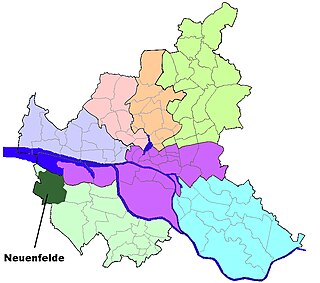Related Research Articles

Dithmarschen is a district in Schleswig-Holstein, Germany. It is bounded by the districts of Nordfriesland, Schleswig-Flensburg, Rendsburg-Eckernförde, and Steinburg, by the state of Lower Saxony, and by the North Sea. From the 13th century up to 1559 Dithmarschen was an independent peasant republic within the Holy Roman Empire and a member of the Hanseatic League.

Altona, also called Hamburg-Altona, is the westernmost urban borough (Bezirk) of the German city state of Hamburg. Located on the right bank of the Elbe river, Altona had a population of 270,263 in 2016.

Arp Schnitger was an influential Northern German organ builder. Considered the paramount manufacturer of his time, Schnitger built or rebuilt over 150 organs. He was primarily active in Northern Europe, especially the Netherlands and Germany, where a number of his instruments still survive.

The Duchy of Saxe-Lauenburg, was a reichsfrei duchy that existed from 1296 to 1803 and again from 1814 to 1876 in the extreme southeast region of what is now Schleswig-Holstein. Its territorial center was in the modern district of Herzogtum Lauenburg and originally its eponymous capital was Lauenburg upon Elbe, though the capital moved to Ratzeburg in 1619.

The organ of the St. Jacobi Church in Hamburg, was built from 1689 to 1693 by the most renowned organ builder of his time, Arp Schnitger. The organ boasts four manuals and pedal with 60 stops, 15 of which are reeds – and has approximately 4000 sounding pipes. All in all, from the organ's original installation and its condition today not much of its conception has changed. The old pipework and the prospect pipes have been preserved in almost original format. It is the largest organ in existence from before 1700 and is one of the most eminent Baroque instruments that have been preserved.

Barmstedt is a town in the district of Pinneberg, in the south of Schleswig-Holstein, Germany. It is situated approximately 8 km northeast of Elmshorn, and 30 km northwest of Hamburg. It has approximately 10,400 inhabitants which makes it the smallest town in the Pinneberg district.

Ottensen is a former town located in Hamburg, Germany in the Altona borough on the right bank of the Elbe river. It is a now one of the 104 quarters of Hamburg.

is a rural quarter located in the borough Harburg of Hamburg, Germany near the Lower Saxony border. The quarter is well known for its quality of fruit and unique houses, many of which prove to be popular attractions for tourists passing through, it belongs to the Altes Land region and is quite known for the cherry and apple tree blossom. In 2020 the population was 4,883.

Schwabstedt is a municipality in the district of Northern Frisia (Nordfriesland), in Schleswig-Holstein, Germany.

is a western quarter of the city of Hamburg in Germany, it is subject to the district/borough Bezirk Altona and was an independent settlement until 1890. It is home to DESY and the Barclays Arena. In 2020 the population was 29,652.
The city of Hamburg in Germany is made up of seven boroughs and subdivided into 104 quarters. Most of the quarters were former independent settlements. The areal organisation is regulated by the constitution of Hamburg and several laws. The subdivision into boroughs and quarters was last modified in March 2008.

Glücksburg Castle is one of the most significant Renaissance castles in Northern Europe.

Maria of Brunswick-Wolfenbüttel was a princess of Brunswick-Wolfenbüttel by birth and by marriage Duchess of Saxe-Lauenburg.
Wilhelm Christian August Heering was a German botanist.

Christian Flor was a German composer and organist. Working at churches in Rendsburg and Lüneburg, he was widely known for vocal and organ compositions. He composed one of the earliest Passion oratorios, in 1667.
Christoph Treutmann ), also Christoph Treutmann der Ältere unlike his son of the same name, was a German organ builder of the Baroque period. He learned in Magdeburg from Heinrich Herbst and also founded his own workshop there. His most important surviving work is the great organ of the Stiftskirche Grauhof.
Gottfried Fritzsche was a German organ builder.
Hans Christoph Fritzsche was a German organ builder from Dresden who worked in northern Germany, Denmark and southern Sweden.

Tobias Heinrich Gottfried Trost was a leading Thuringian organ-builder. Johann Sebastian Bach held him in high regard. His organs in the city church of Waltershausen (1722–1730) and in the Altenburg Palace (1735–1739) are amongst the best-known Baroque organs of middle-Europe, and are largely preserved in their original state.